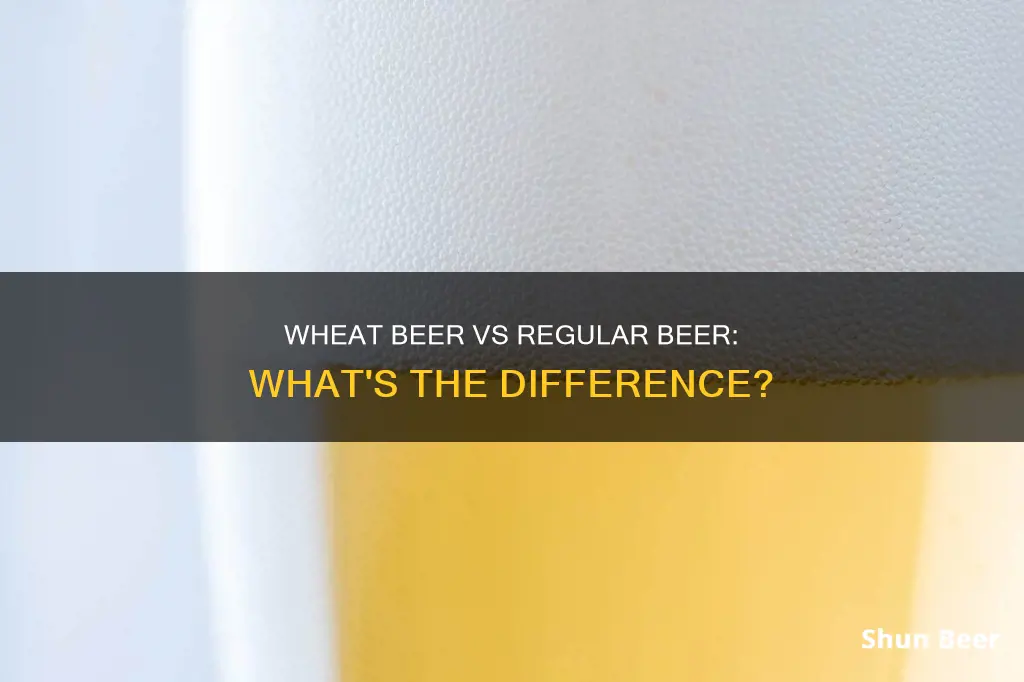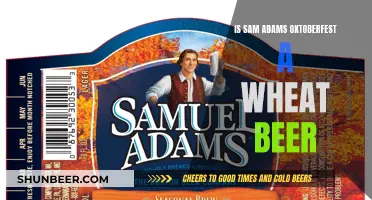
Wheat beer and regular beer differ in several ways, including their ingredients, brewing processes, and resulting flavours and appearances. Wheat beer, as the name suggests, contains a significant proportion of wheat, typically at least 30%, in addition to barley. Regular beers, on the other hand, primarily use barley, rye, or adjuncts like rice and corn as their base grain. Wheat beers often use top-fermenting yeast, resulting in a cloudy appearance and flavours like banana and clove, while lagers tend to use bottom-fermenting yeast and have a crisp, clean taste. Wheat beers are typically light in colour, low to medium in alcohol content, and can be brewed with or without hops, whereas regular beers can vary widely in colour, style, and alcohol content.
| Characteristics | Values |
|---|---|
| Appearance | Wheat beers are usually cloudy, but can also be clear. |
| Alcohol Content | Wheat beers are typically low to medium in alcohol content. |
| Bitterness | Wheat beers tend to lack bitterness. |
| Brewing Process | Wheat beers are top-fermented ales, brewed with at least 30% wheat. |
| Calories | Wheat beers have more calories than light lagers, but are similar to full-strength beers. |
| Flavour | Wheat beers have notes of banana, clove, and sometimes citrus. |
| Origin | Wheat beer originated in Bavaria, Germany. |
What You'll Learn

Wheat Beer Styles
Wheat beer is a category of beer that originated in Bavaria, Germany. It is typically a top-fermented ale, uses at least 30% wheat in the brewing process, and comes in a variety of styles. Wheat beers are usually light in colour, low to medium in alcohol content, and can be cloudy or clear. They tend to lack bitterness, making them easy to drink.
Hefeweizen
Hefeweizen is a Bavarian-style wheat beer that is light in colour and cloudy in appearance. The yeast used in the brewing process adds notes of banana, bubblegum, and clove to the beer. Some popular examples of Hefeweizen include Paulaner Hefe-Weizen and Kellerweis from Sierra Nevada.
Dunkelweizen
Dunkelweizen is a variation of Hefeweizen that uses a more roasted malt, resulting in a slightly darker, brown beer. ("Dunkel" means "dark" in German.) In addition to the banana and clove notes typical of Hefeweizen, Dunkelweizen also exhibits flavours of caramel and roasted malt. Sam Adams Dunkelweizen, Shiner Holiday Cheer from Spoetzl Brewery, and Leavenworth Boulder Bend Dunkelweizen from Fish Brewing Company are some well-known examples of this style.
Weizenbock
Weizenbock is a stronger version of Hefeweizen, with more pronounced fruit and malt flavours. It may have a slightly creamy texture, and its higher alcohol content is noticeable. Notable examples of Weizenbock include Moonglow Weizenbock from Victory Brewing Company and Ayinger Weizenbock.
Witbier
Witbier is a Belgian-style wheat beer characterised by flavours of banana, clove, bubblegum, orange peel, and coriander. The most popular Witbier is Hoegaarden, while another well-known example is White Rascal from Avery Brewing Co.
Berliner Weisse
Berliner Weisse is a northern Bavarian style that is light and sour, often mixed with fruit. Some breweries that produce this style include New Belgium Brewing Co. (Yuzu), Dogfish Head (Festina Peche), and New Glarus Brewing Co.
American Wheat
American Wheat is the American interpretation of German wheat beer. It is generally lighter and more adaptable, with hoppy versions also available. Examples of American Wheat beers include Sierra Nevada's Hoppy Wheat IPA, American Expedition from Heritage Brewing Co., and Widmer Brothers Brewing's Hefeweizen.
Stella Artois: Wheat Beer or Not?
You may want to see also

Wheat Beer Taste
Wheat beer is a category of beer that typically uses at least 30% wheat in the brewing process, with some styles using over 50%. Wheat beers are usually top-fermented ales, though not always, and are often light in colour, low to medium in alcohol content, and can be cloudy or clear. They tend to lack bitterness, making them easy to drink.
Wheat beers are known for their distinctive use of wheat malt in addition to the traditional barley malt. The wheat content contributes to their cloudy appearance and distinctive flavours like banana, bubblegum, and clove. The yeast used for wheat beers, such as ale yeast, also contributes to their unique flavour profile. Unlike lagers, which use bottom-fermenting yeast, wheat beers use top-fermenting yeast that rises to the top of the fermenter and ferments at warmer temperatures. This yeast tends to create fruity and spicy notes in the beer.
The most widely known wheat beer is hefeweizen, a refreshing style from Germany that's popular around the world. Other popular styles of wheat beer include Dunkelweizen, a darker version of hefeweizen with notes of caramel and roasted malt, and Weizenbock, a stronger hefeweizen with more fruit and malt flavours. Witbier, or white beer, is a Belgian style of wheat beer that is also cloudy and spiced with coriander and orange peel. Berliner Weisse is a northern Bavarian style that is light and sour, often mixed with fruit.
American wheat beers are typically lighter and more adaptable, with a more noticeable hop character. They can range from relatively clear to cloudy and tend to be crisper in texture compared to other wheat beers.
Wheat beers are typically highly carbonated and are best served at 45 to 50 degrees Fahrenheit in a flute or vase glass. They are light, summery, and refreshing, making them a perfect choice for the warmer months.
Wheat Beer's Acidity: What's the Truth?
You may want to see also

Wheat Beer Calories
Wheat beer, also known as hefeweizen, is a category of beer originating in Bavaria. It is typically a top-fermented ale, uses at least 30% wheat in the brewing process, and comes in a variety of styles. Wheat beers are usually light in colour, low to medium in alcohol content, and can be cloudy or clear. They are also often low in bitterness and highly carbonated, making them easy to drink.
The calorie content of wheat beer varies depending on the brand and style. Here is a breakdown of the calorie content of some popular wheat beers:
- Bud Light Golden Wheat: 118 calories per 12 oz serving.
- Sierra Nevada Wheat Beer: 153 calories per 12 oz serving.
- Samuel Adams Cherry Wheat: 176 calories per 12 oz serving.
- Samuel Adams Dunkelweizen: 168 calories per 12 oz serving.
As you can see, the calorie content of wheat beers can range from around 118 to 176 calories per 12 oz serving. The calorie count will depend on the specific ingredients and brewing processes used by each brewery.
When comparing wheat beer to regular beer, it is important to note that the calorie content can vary between different styles of regular beer as well. For example, a typical lager might have a different calorie count than a pilsner or an IPA. However, wheat beers tend to be on the lower end of the calorie spectrum, especially when compared to darker, heavier beers.
Leffe Blonde: Wheat Beer or Not?
You may want to see also

Wheat Beer Brewing Process
Wheat beer is typically a top-fermented ale that uses at least 30% wheat in the brewing process and comes in a variety of styles. The wheat portion can range from 30% to 70% of the total, with wheat extract malts typically being 40% wheat and 60% barley.
- Milling: For wheat beer, a finer mill setting is required compared to other beers. This is because wheat kernels are smaller and denser, so a tighter setting is needed to crack them effectively. However, be careful not to make the setting too fine, as this can cause issues with the mash.
- Dough-in and hydration: Hydrate the grain thoroughly before doughing-in to ensure the grain and water are evenly blended for mashing.
- Lautering: When lautering wheat beer, be prepared to use a delicate method to cut the grain bed, such as a stick, canoe oar, or long stainless steel serving spoon. Start lautering slower than usual to avoid drawing the grain into the screen. Wheat beers typically have a slower runoff due to the higher protein content in wheat.
- Boiling: Aim for a good boil to coagulate proteins and achieve a hot break. You can also add hops during this stage for bittering, flavour, or aroma.
- Cooling and pitching yeast: Cool the wort and then pitch a healthy, active yeast strain. For Bavarian-style wheat beers, the recommended yeast is Weihenstephan or Wyeast 3068, which adds banana and bubble gum aromas. The fermentation temperature should be around 70° F (68° to 72° F is a good range).
- Fermentation: Ferment the beer for three to five days. The warmer the fermentation temperature, the more esters will be produced. For a heavy banana aroma or bubble gum flavour, ferment at 72° F.
- Racking: About 12 to 15 hours after brewing, once you've added yeast, rack the beer off of the cold break into another fermenter.
- Bottling or kegging: After fermentation is complete, bottle or keg your wheat beer.
Blue Moon Honey Wheat Beer: Strong, Sweet, and Refreshing
You may want to see also

Wheat Beer History
Wheat beer is a category of beer that originated in Bavaria, Germany, and typically uses at least 30% wheat in the brewing process. However, the history of using wheat in brewing goes back much further, possibly as early as Babylonian times, as ancient Egyptian hieroglyphics illustrate the use of two different grains.
The Bavarian style of wheat beer was introduced to the region in the 15th century from neighbouring Bohemia. However, until 1548, only beer made from barley was allowed to be brewed in Bavaria due to the Reinheitsgebot law. This changed when William IV, Duke of Bavaria, granted special privileges to Baron Hans VI von Degenberg to brew and sell wheat beer.
The Degenberger clan held exclusive rights to brew wheat beer for decades, until they died out, after which these privileges were passed on to the Bavarian Dukes. In 1589, Bavarian Duke Maximillian I built the "Hofbräuhaus am Platzl", which still stands today as the location of the Ducal Weissbier brewery.
By the 1700s, improvements to barley malt beers led to a decline in the popularity of wheat beers, and by the mid-19th century, they had almost fallen out of favour entirely. It was at this time that George Schneider, owner of the Munich brewery, released the Weissbier rights to the public, allowing anyone to brew wheat beers.
Following World War II, wheat beers experienced a resurgence in popularity, and today they account for a significant portion of all beer sold in Bavaria and Germany.
The most well-known wheat beer style is Hefeweizen, a refreshing German beer that is popular around the world. Other wheat beer styles include Berliner Weisse, a cloudy and sour beer from Berlin; Gose, a sour and salty beer; and Lambic, made with wild yeast.
Filtering Wheat Beer: The Process Explained
You may want to see also
Frequently asked questions
Wheat beer is any beer made up of at least 30% wheat, though some sources state at least 50% wheat. Wheat beers are typically light in colour, low to medium in alcohol content, and can be cloudy or clear.
Regular beer, or lager, is brewed with barley and bottom-fermenting yeast, offering a crisp and clean taste. Lagers are typically lighter and crisper than wheat beers.
Wheat beer uses top-fermenting yeast that operates at warmer temperatures, usually between 60°F and 75°F (15.5°C – 24°C). Lager uses bottom-fermenting yeast that works at colder temperatures, typically between 35°F and 50°F (1.7°C – 10°C).
Wheat beers often have a distinctive taste and aroma with notes of banana, clove, and sometimes citrus. Lagers can range from sweet to bitter, depending on the hops used, and typically have a more balanced and less pronounced hop flavour compared to some ales.







